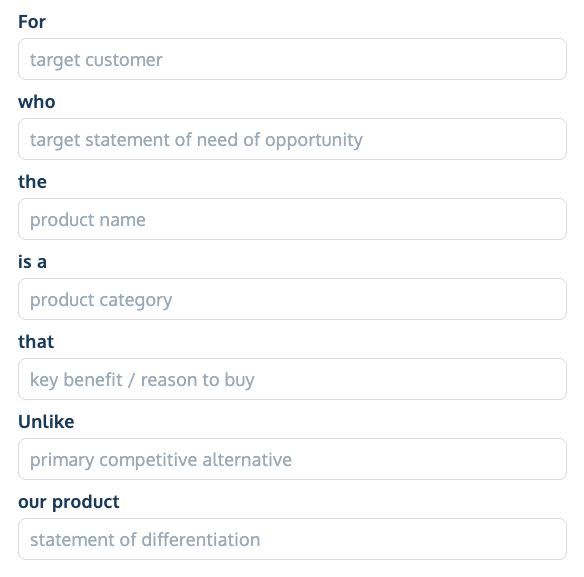8 Great Product Vision Examples
“Any progress starts with a mission, a vision.”
Not our words – they’re the words of one of the modern era’s great thinkers: Arnold Schwarzenegger. And, yeah, Arnie’s right. It’s difficult to build a business (or a bicep) without a clear vision of where you’re headed and what it is you’re trying to achieve.
That’s where a vision statement comes into play. In product development, a vision statement sets out your grand plans and aims for the product – what you would like it to do, who it’ll do it for, and what that will mean for the world at large.
It can be a tricky thing to get right, but it’s a really important thing to nail. Crafting a vision statement that really encapsulates the lofty goals you have for your product(s) can galvanize entire teams, shine a light on the best course of action, and drive next-level focus on what matters and what needs to change.
That might sound like a lot of heavy lifting for one or two pithy sentences, but it’s true.
Articulating a vision is a surefire way to sort the signal from the noise when it comes to product road mapping. You’re probably bone-tired of people throwing the phrase ‘north star’ around willy-nilly, but that’s pretty much what a vision statement is; it’ll guide you through the murky waters of feature requests, budget constraints, and stakeholder demands. It’s what you lock your sights on to find your direction of travel.
Or, as Arnie puts it, a vision statement “gives you something to shoot for.”
If that sounds like something you need to work on, let’s start by taking a look at the core tenets of great product vision statements.
In this article we’ll cover:
- What makes a great product vision statement?
- Mission statement vs vision statement
- How do you write a vision statement?
- 8 great product vision examples
- Why does all this matter?
What makes a great product vision statement?
First up, it’s worth covering how a product vision statement differs from a company vision statement.
It’s easy to get the two mixed up, and there is definitely some overlap, but the key difference is that your company goals tend to be broader and more conceptual, whereas designing a vision for a product is usually more about what you want that specific thing to do for people and its position in the market.
As an example, let’s take a look at some product vision examples from Disney, Apple, and Amazon:
Disney
‘To be one of the world’s leading producers and providers of entertainment and information’
Amazon
‘To be Earth’s most customer-centric company, where customers can find and discover anything they might want to buy online’
Apple
‘To make the best products on earth and to leave the world better than we found it’
These are all solid aims, but they each refer to their respective companies as entities, rather than specific products. While a product vision statement should absolutely align with your company’s overall goals, there is a difference between the two statements.
Apple, for example, has set out its stall to create great products and make a positive impact on the world, but that’s not a vision for any specific product. If we were to try and draft a vision statement for the iPhone line instead, we might look at how Steve Jobs pitched it during its initial debut: “An iPod, a phone, an internet mobile communicator; a revolutionary and magical product that is literally five years ahead of any other mobile phone.”
And then we could refine that to something like: ‘To offer a magical experience that’s always years ahead of the competition.’ But, you know… We probably don’t need to teach Apple what its goals are for iPhones.
Either way, a great product vision statement should be clear, concise, and really compelling. But it should also be actionable. That means it should provide a clear direction for your team to move towards, without sacrificing that sense of lofty ambition.
Mission statement vs vision statement
Generally, the difference between these two terms is that a mission statement refers to the now, and a vision statement refers to the future. Your mission statement sets out why a company or product exists, and what sets it apart.
A vision statement shares some overlap, but the idea is to think about what you ultimately want your product to achieve. What’s the main goal? The big dream? What is your ideal outcome for the future? That’s what a vision statement explores.
How do you write a vision statement?
So how do you manage all that? A great start is to use our free vision statement template, which can help do some of the thinking for you.
The format we use here is straightforward enough to help you articulate your goals by breaking down your product’s purpose, audience, and market positioning:

So, to fill that out with a fictitious product in the SaaS space, we might say…
For small-to-medium-sized businesses that need a comprehensive project management solution, TaskBuster Pro is a cloud-based software that streamlines team collaboration and increases productivity. Unlike other project management tools that are complex and difficult to use, our product has a user-friendly interface and offers advanced features such as resource scheduling and budget tracking.
That elevator pitch provides clarity and concision, but it’s not the end of the process. Once you’ve got those core details locked in place, you can the next step is to think about where you want that product to go.
The paragraph above describes what TaskBuster Pro is and who it’s for, but not its eventual goal. So we might use that as a springboard and decide that, ultimately, we want this product to be the de facto office organizer. Or that we want this product to save every office worker on Earth one day a month. These are closer to true vision statements than our starting point, but it’s hard to get to that stage without that initial clarity.
The idea is to play around with the wording until you hit that perfect balance of aspiration and actionability; the art of the product vision statement is in taking that full explanation of your future goals and chipping things away until you’re left with a punchy line or two that says a lot with a little.
Remember: a great vision statement should be concise, memorable, and speak to the future of your product. Even though it’s an internal resource, you should be happy enough with it that it could act as a public-facing advertising slogan on a city-sized billboard.
Get instant feedback on your Vision Statement with ProdPad’s AI Product Coach. Start your free trial, add your Vision to the Product Canvas and click the AI Coach to get a full analysis complete with suggested improvements.
Start your free trial now and get feedback right away!
Need some inspo? Let’s take a look at some product vision statements from some of the world’s biggest companies…
8 great product vision examples
1. Slack: ‘To make work life simpler, more pleasant, and more productive’

You’ll notice that, as with a lot of the product vision examples we’ll cover in this list, there’s nothing here about features, pricing, or technology. Instead, Slack’s promoting the core benefits that using its software enables. Having a simpler, more pleasant, and more productive working life is the (proposed) outcome of using Slack – so the vision statement here is customer-centric and focuses on its use case. It’s an important example because people are always drawn more toward outcomes than methodologies.
2. Zoom: ‘To make video communication frictionless’

Short, sweet, and powerful. The word ‘frictionless’ is really the focal point here, and it’s a great choice. During the pandemic, Zoom usurped industry stalwarts like Skype – and left rivals like Microsoft and Google scrambling to catch up – because of one incredibly disruptive characteristic: extreme ease of use. It won out because of how simple it was to set up and share call invites, whether you were in the boardroom or just wanted to win a family quiz, and without your invitees even needing an account. So when Zoom uses the word frictionless here, it’s really summing up its biggest strength.
3. Shopify: ‘To make commerce better for everyone’

As with Zoom, there’s one word here that’s working pretty hard: ‘everyone’. What works with Shopify’s vision statement is that it describes what the product enables (commerce), but is clear that its goal isn’t just to make the commerce experience great for the seller or the customer – but both of them. It paints a picture of an eCommerce product that’s enjoyable to use for both sides of the equation, which is a great goal to explicitly state because that’s exactly the kind of mission that defines the UI and UX of a product.
4. LinkedIn: ‘To create economic opportunity for every member of the global workforce’

What LinkedIn is doing here is driving at something bigger than the sum of its parts. As a product, LinkedIn is multifaceted – with goals that differ based on the user. For instance, marketing LinkedIn as a tool for recruiters is a different ballgame from persuading employees and applicants to use the platform to find a job. As a result, its vision statement needs to bridge that divide with a desire that both audience types can identify with: economic opportunity. It’s clever, catch-all terminology that states a goal while also being aspirational.
5. Instagram: ‘To capture and share the world’s moments’

Capture and share. That’s Instagram in a nutshell. But what really works about this, aside from how succinct it is, is that ‘capturing moments’ conjures up some degree of FOMO. The goal of the product is to be a platform people want to use because it’s where things are actually happening. Capturing the world’s moments speaks to global ambitions, community, and a sense of purpose.
6. Google: ‘To provide access to the world’s information in one click’

Without ‘in one click’, this could just as easily be a vision statement for Google as a company. But it’s that pragmatic criteria that’s so important here because Google’s created a rod to beat itself with. Or, in other words: a design principle that should keep Google as a service on the straight and narrow. Providing access to the whole world’s information? That’s a huge goal. But to ensure that it’s always an easy and quick experience? That right there is a USP.
7. Netflix: ‘To become the world’s leading streaming entertainment service’

If your TV has been slowly busying up with streaming services over the past few years, you’ll probably recognize that Netflix doesn’t always pump out the very best stuff compared to some of its closest rivals. But it does make a WHOLE LOT of content, right? And, hey, that’s totally in line with the company’s vision for Netflix as a product: the line here isn’t ‘make the very best content’, after all, it’s just to become the market leader. Scale is more important than quality, in other words. And, if you ask us, that certainly seems to be shaping Netflix’s direction of travel.
8. Uber: ‘Evolving the way the world moves’

A vision statement needs to reflect everything your product does, so – if your product’s scope has changed – it’s worth checking to see if your vision statement is still relevant. What’s that got to do with Uber? Well, Uber is now a suite of products, rather than just a taxi-booking solution. It’s also a food delivery business, for one, and it’s also investing heavily in driverless car solutions. Luckily, ‘evolving the way the world moves’ fits this evolving scope much more than something like ‘evolving the way people order cabs.’
Why does all this matter?
Don’t make us share that Arnie Instagram post again.
At the end of the day, it’s impossible to drive meaningful growth without an idea of where you want to end up. You can’t run a marathon if there’s no finish line, and you can’t develop a market-leading product if you don’t know what success looks like.
Crafting (and sticking to) your product’s vision statement is a crucial part of its inception and growth; it’s how you’ll choose a destination and it’s how you’ll make it there with your whole team aligned.

